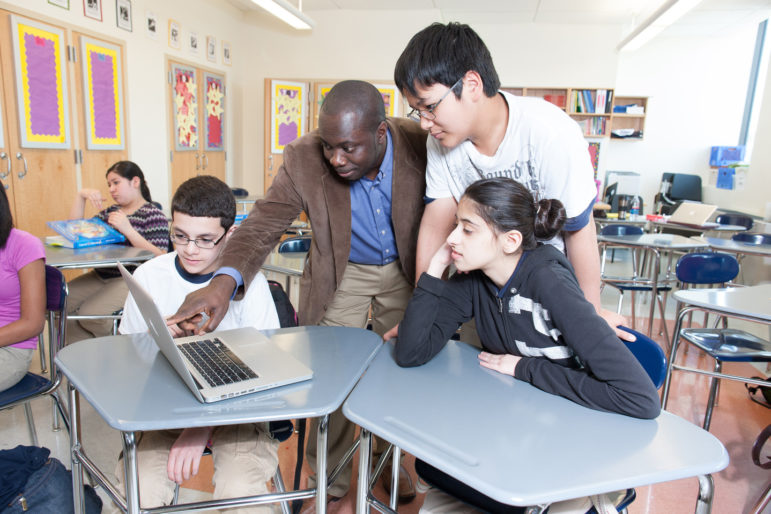
Teaching Matters
‘e know that to attain equity, we need to develop and distribute excellent teachers more fairly, not just to the economically advantaged.’
The nucleus of NYC Schools Chancellor Richard Carranza’s administration has concentrated on race, class, and equity, as it should. Schools in our city have the tendency to mirror New York’s zip-code income brackets and consequently, devastating racial and socioeconomic divisions that often dictate the quality of a child’s education. Low-income, primarily Black and Latino children generally have less access to high-quality education than their White, economically advantaged counterparts.
To reach true education equity, we need to disrupt historical patterns that harm students from marginalized communities by taking three initial steps: staffing experienced teachers in high-needs schools, teaching with culturally responsive curricula, and eliminating assessments that promote segregation.
On the Upper East Side in zip code 10021, where a resident’s average income is nearly $115,500, students make their way to a Blue Ribbon School elementary school, recognized by the U.S. Department of Education for overall academic excellence. 85 percent of teachers have three or more years of experience, and 68 percent of the student population is White.
The snapshot of an elementary school in the Bronx zip code of 10472, where a resident’s average income is under $15,000, is drastically different. The student population is flipped—95 percent of students are Black or Hispanic, and the number of experienced teachers pales in comparison to the school in the wealthier zip code. Only 40 percent of educators have been teaching for at least three years.
At the beginning of this year, it was designated as a low-performing school by the state.
Too many schools in neighborhoods with high concentrations of poverty have a particularly steady revolving door of inexperienced teachers. New teachers in the Bronx and Harlem are leaving the classroom at higher rates than anywhere else in Manhattan. Schools should be staffed by a combination of experienced and new teachers, but in New York City, schools are often made up of only one or the other. The first step in progressing towards equity is enticing experienced teachers to work in low-income schools.
A new study found poverty impacts achievement gaps more than race, and students of color tend to be concentrated in high-poverty schools with less-experienced teachers, high turnover rates and fewer resources. Citywide, approximately one-third of teachers have fewer than five years of experience and on average, turnover rates across all public schools in New York City are about 15 percent.
My nonprofit, Teaching Matters, works in high-poverty schools to develop great teachers and improve student success. We know that to attain equity, we need to develop and distribute excellent teachers more fairly, not just to the economically advantaged.
Teaching Matters also instructs on how to successfully implement culturally responsive education (CRE), the second critical step towards advancing educational equity in our City. CRE is not just about celebrating a diversity of cultures but about changing mindsets and recognizing privilege and bias. Though we have a long way to go, I applaud Chancellor Carranza for formally adopting a CRE policy earlier this year.
Research shows students learn better when their cultures and identities are reflected in what they study. At M.S. 88 in Brooklyn, the library saw a 70 percent increase in circulation of their books once they made their library more culturally responsive. From a budget perspective, schools and districts need to seriously consider allocating money to providing CRE training for educators.
To be sure, progress is being made by New York City legislature to desegregate schools and reinforce the capacities of teachers. In 2017, Mayor Bill DeBlasio appointed education professionals from around the city to the School Diversity Advisory Group. Their task was to study barriers and make public schools more equitable. Chief among their recommendations from their first report was the third step towards creating education equity: eliminating the current gifted and talented assessments.
Even though Black and Latino children make up the majority of the city’s public school population, the city’s gifted and talented classes are comprised of almost 75 percent White and Asian students.
The assessment to enter the program in Kindergarten is effectively inaccessible and discriminatory to most students because of this limited point of entry. And like many assessments, those with the resources to prep for the test have a higher chance of succeeding. If an assessment is inherently biased, we need to come up with an alternative solution.
To begin the process of desegregating NYC’s public schools, we need to first equip teachers for long-term efficacy in high-needs districts. We must build on the momentum created with the introduction of CRE, and the gifted and talented admissions system must be reformed.
There are countless barriers for children from underserved communities to overcome, but access to a high-quality education should not be one of them. Together can create a foundation upon which a prosperous and equal NYC public school system can be rebuilt.
Guastaferro is the CEO of Teaching Matters, a nonprofit that increases teacher effectiveness to improve student success, so every child has equitable access to excellent teaching, regardless of zip code.








